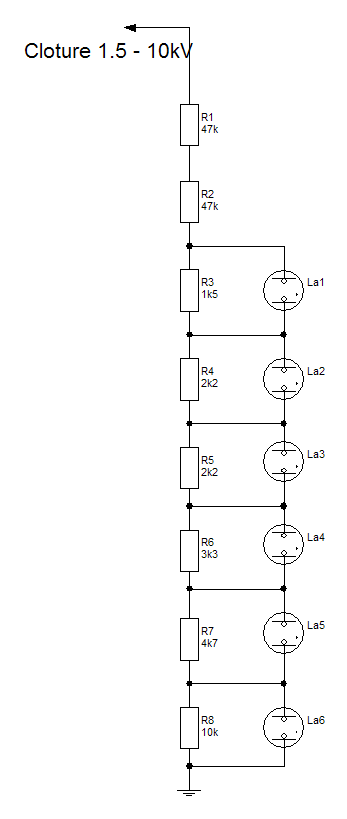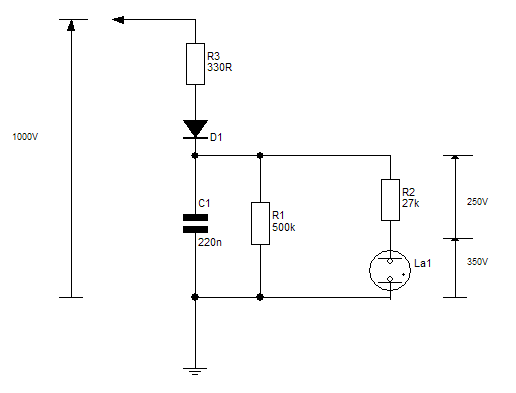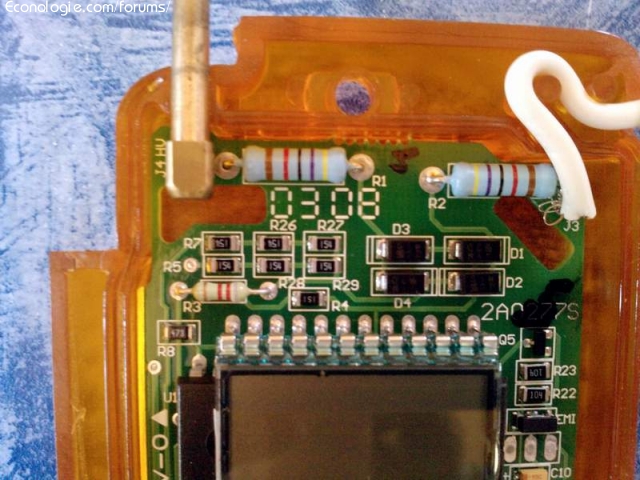Grelinette wrote:Perhaps this reliable, efficient, easy to plug in (and tinker) and inexpensive hardware can serve as the basis for the system? ...
It is exactly the same kind of tester that I bought in order to read the values of the resistors used.
By cons cheap I would not say that. I paid mine 15 euros when there are barely 5 euros for components.

When we open it, we find this: (it couldn't be simpler: 8 resistors and 6 neon lights)

I noted the diagram of this kind of tester that here:

The problem with this kind of tester is that the very short pulses of the energizers hardly make small flashes in the lamps, which makes reading very difficult.
In the battery-powered energizer that I use they alleviated this problem by adding additional components.
One day I took advantage of dismantling it to take up the diagram of this light here. It should be noted that that is only supplied at 1000V because an intermediate socket on the high voltage transformer has been specially fitted for this indicator.

Starting from all this I therefore deduced this diagram (which I repost in this subject for the third time)

Which works perfectly apart from a small problem of too high tension at the level of the falling resistances (the 4 of 2.7kohms) which I think to replace by 8 of 1.2 or 1.5kohms
Note that personally I rather use a "digital" closing tester which indicates the voltage with a resolution of 100V but which is, when you buy it, a little more expensive (I had benefited from a promotion at the 'when I bought a mains energizer, the digital tester was offered)

This tester, as advanced as it is, also uses the principle of the resistive divider bridge to make its measurement, at least for the first stage. I have not studied it too much.

Some manufacturers, however, use the capacitive effect in some of their testers. it allows for example to have testers that work without earth (I had one in my youth, that I had paid a small fortune)
See “Digivolt” or “Control beep” from Lacmé for example.
http://www.lacme.com/Scripts/WebObjects ... ?idDep=416
Your table is interesting because it shows that, as I explained above, the current delivered in an electric fence perhaps very important is to exceed the ampere.
the data is confirmed in any serious manual of electric energizer
http://www.lacme.com/rd/613600_NU01.pdf
We note that an energizer of 0.8J is capable of delivering a voltage of 3800V on a load of 500ohms.
if we apply the law of ohm that gives? I = 3800/500 = 7.6A!
It is this characteristic which allows the "modern" energizer known as low impedance, to be able to continue to deliver a significant tension is thus efficient even if there is a lot of fault on the fence (grass which touch the wire) there or the energizers of (very) old generation, called later "high impedance" saw their output voltage collapse with the first blade of grass which came to touch the fence.
The "low impedances" on the other hand have much shorter pulses, where the "high impedances" took their time.
Yes, because what is dangerous is not only the current, but also the duration of the passage of the current. Besides when we pass an electrical habitation the gentleman trainer shows us nice curves where the danger threshold is given not only by the value of the current, but also by the duration of passage of said current.
see page 5 (and again the curve starts at 10ms, which is already very long)
http://lp-ampere-72.ac-nantes.fr/IMG/pd ... humain.pdf
With an electric fence the pulses are very very short, which means that even a large current is normally not dangerous.
In addition someone touching the fence will not be crossed by such a current because the human body has a resistance much greater than 500 ohms (especially with shoes)
To finish this little explanation we can do another calculation.
If we take the example above have at 3800V under a current of 7.6A
Knowing that the shock energy is only 0.8J anyway
according to wikipedia E (joules) = R (ohms) xI² (amp) xT (seconds)
we set 0.8 = 500x7.6²xT
T = 0.000028 seconds or 28 micro seconds
(we can also do this with E = U² / R x S because RxI² = U² / R)
This also explains why it is so hard to see the loupes of the basic fence testers, because in fact we have to "guess" them more by retinal percistance effect than to really see them.
Note that Gallagher (who is my favorite manufacturer of fencing equipment) seems to have put on the market exactly the device that we are trying to develop.
http://www.gallaghereurope.com/france/g ... tnr=055654
only its price is a little dissuasive.




